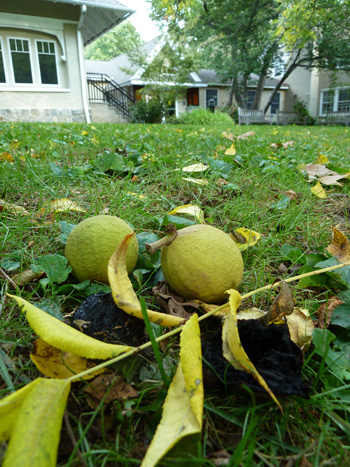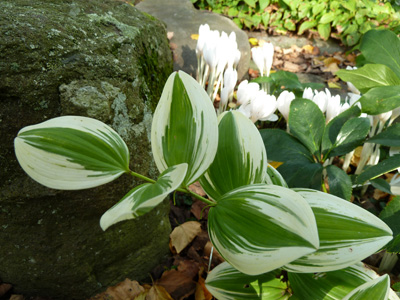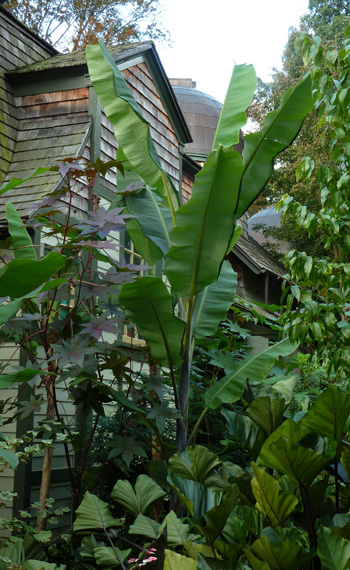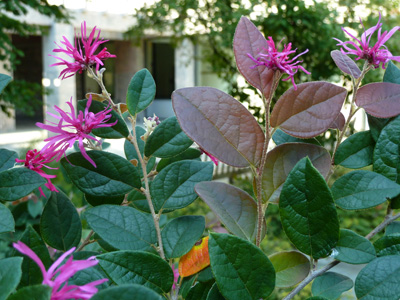Plants of the Week – October 1
Introduced to the United States by the U.S. National Arboretum, Loropetalum chinense var. rubrum ‘Blush’ is in full bloom in the Cosby Courtyard. While the cultivar typically flowers in mid-spring, fall flushes of bloom are not uncommon. The selection, also marketed and sold as Razzleberri® is unique for being a pink-flowered form of the typically white-flowered species, Loropetalum chinense. Attributes of the cultivar include burgundy-red new growth, floriferous witch hazel-like pink flowers, and an ability to serve a variety of purposes from being planted as a specimen to mass planting and container gardening. Photo credit: J. Coceano
 One fall chore from my childhood was collecting the fruits of Juglans nigra, the black walnut. My sister and I would fill a burlap sack with the green fruit and store it in the barn away from the multitude of busy squirrels. The green husks dried allowing easy access to the nut. A word of warning: Juglans nigra fruits contain juglone, plumbagin, and tannin which will stain hands, clothes, sidewalks and just about any other surface. The species is fascinating, and numerous sources provide detailed information from the trees’ toxicity to other plants to “walnut rustlers”, thieves known for their elaborate techniques to secure the highly prized timber. Photo credit: J. Coceano
One fall chore from my childhood was collecting the fruits of Juglans nigra, the black walnut. My sister and I would fill a burlap sack with the green fruit and store it in the barn away from the multitude of busy squirrels. The green husks dried allowing easy access to the nut. A word of warning: Juglans nigra fruits contain juglone, plumbagin, and tannin which will stain hands, clothes, sidewalks and just about any other surface. The species is fascinating, and numerous sources provide detailed information from the trees’ toxicity to other plants to “walnut rustlers”, thieves known for their elaborate techniques to secure the highly prized timber. Photo credit: J. Coceano
 Polygonatum odoratum ‘Carlisle’ is a beautiful Solomon’s seal on its own but even more striking when partnered with Colchicum speciosum ‘Album’. The NARGS forum, North American Rock Garden Society, states that the selection will likely become the new standard for variegated forms of P. odoratum with its wide bands of variegation. The chance seedling was named by Leo Blanchette, owner of a nursery in Carlisle, Massachusetts. The combination can be seen in the Harry Wood Garden. Photo credit: J. Coceano
Polygonatum odoratum ‘Carlisle’ is a beautiful Solomon’s seal on its own but even more striking when partnered with Colchicum speciosum ‘Album’. The NARGS forum, North American Rock Garden Society, states that the selection will likely become the new standard for variegated forms of P. odoratum with its wide bands of variegation. The chance seedling was named by Leo Blanchette, owner of a nursery in Carlisle, Massachusetts. The combination can be seen in the Harry Wood Garden. Photo credit: J. Coceano
 Musa balbisiana ‘Black Thai’ bears stems and leaves that are thinner than other cultivars and selections in the genus. The pseudostem is eye-catching with its near black coloration. The cultivar is slow to grow in the cool spring and early summer soils but quickly takes off, reaching upwards of 18’ in height, once the heat of summer sets in. Plant in a sheltered location to avoid wind damage. Photo credit: J. Coceano
Musa balbisiana ‘Black Thai’ bears stems and leaves that are thinner than other cultivars and selections in the genus. The pseudostem is eye-catching with its near black coloration. The cultivar is slow to grow in the cool spring and early summer soils but quickly takes off, reaching upwards of 18’ in height, once the heat of summer sets in. Plant in a sheltered location to avoid wind damage. Photo credit: J. Coceano






John Schucker
Posted at 07:40h, 12 OctoberIs Musa balbisiana hardy in our region?
Can you please identify the plant in the foreground of the musa photo with the arrow head shaped erect leaves?
Thanks very much.
Josh Coceano
Posted at 12:49h, 16 OctoberHi John,
We overwinter the Musa and Ensete in a cool basement. They have done well for us using this method. Thus far only Musa basjoo has been in-ground hardy.
The plant in the foreground is Colocasia esculenta ‘Tea Cup’ – great dark purple stems and cup-like leaves. Plants can reach upwards of 6′!
John Schucker
Posted at 07:43h, 19 OctoberThanks, Josh. And did I read correctly you are currently also a 3rd grade teacher in addition to your work at the arboretum?
J
Josh Coceano
Posted at 09:49h, 30 OctoberI was a third grade classroom teacher before joining the Scott Arboretum. Now I work full time with the arboretum.